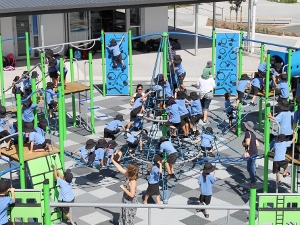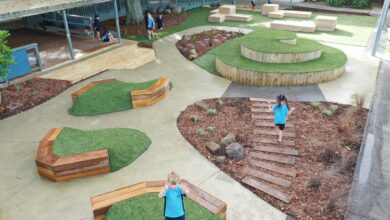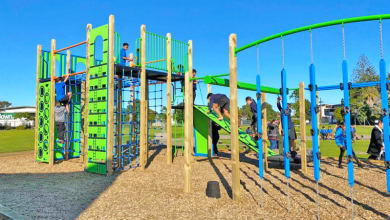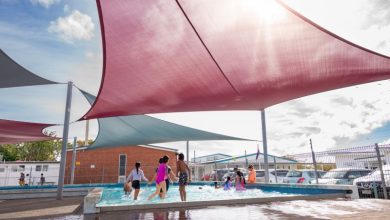Surfacing key part of playground safety

 Playgrounds are an integral part of the outdoor environment at school, providing facilities where students can explore their physical capabilities, gain confidence and social skills and, of course, have fun.
Playgrounds are an integral part of the outdoor environment at school, providing facilities where students can explore their physical capabilities, gain confidence and social skills and, of course, have fun.
For schools installing a new playground or extending an existing one, a key part of the project is the surfacing. This item also represents a significant proportion of the overall cost, and so it is important that careful consideration is given to the type of surface selected.
There are two types available – loose fill, such as wood chip or bark, and unitary, such as rubber wetpour or tiles. Loose fill is less expensive, but unitary surfaces have a longer life, so the choice often comes down to the available funds. Sometimes a school will choose the less expensive option initially, then upgrade to a more durable surfacing a few years down the track.
When comparing quotes for the various options, make sure they are transparent and cover all elements required for the completion of the job.
With any playground surfacing, safety is the most important factor; however, there are a number of other aspects to be looked at, too. Playground surfacing is covered by NZS 5828:2004, and while it is a voluntary Standard, most schools require the playground equipment and surfacing they purchase to comply with the Standard.
There are five Standard requirements, each having a particular test method stipulated. The supplier should be able to provide a test report showing that the product has been tested according to this method and complies with the Standard.
The requirements are as follows:
Critical fall height – applies to both loose fill and unitary surfacing. This is expressed in metres and indicates that the surfacing achieves the impact attenuation requirement of the Standard for free heights of fall up to the stated critical fall height. Whatever the critical fall height of the surface, the equipment used for the playground should not allow a child to be able to fall from a greater height.
Slip resistance – applies to unitary surfacing. The Standard requires a slip resistance of not less than 40 in wet and dry conditions.
Resistance to abrasive wear – applies to unitary surfacing. While not directly a safety issue, a surfacing that wears well will also continue to comply with the other safety requirements, particularly critical fall height and slip resistance.
It also indicates whether the surfacing is likely to provide value for money over time, or whether problems will emerge in high traffic areas and scuff zones.
Resistance to indentation – applies to unitary surfacing. When deformed under a test load the surfacing should return to its original shape without cracking and splitting. The Standard requires that the residual indentation after 24 hours be no more than 5mm.
Ease of ignition – applies to unitary surfacing. The test method involves dropping a super-heated metal nut onto the surface and measuring the distance scorching travels – this must be no more than 35mm.
When you speak to suppliers ask if you can access recent references. Also, have a good look at their warranty to see if it is acceptable to you. The length of the warranty is not always the best guide. A warranty lasting a certain number of years might not be as good as it looks because of the exclusions and a reduction in the dollar value of the warranty over time, so watch out for loopholes and ‘value reduction over time’ clauses.
An analysis undertaken in August 2013 of four US playground surfacing warranties found that not all product warranties cover the whole playground area, with most of them excluding high traffic wear areas. This exclusion effectively negates the entire warranty.
Other exclusions that can negate the warranty include the placement of chairs on the playground and the wearing of certain types of footwear, both of which would be difficult to monitor so could become a matter of dispute in the event of a claim.
It is vital to establish the dollar value of the warranty, i.e. what it covers in the event of a claim. Is it for the full purchase price, does it include freight to the site in the event of replacement, and does it include reinstallation. Half of the warranties analysed did not cover reinstallation costs.
It is essential to have a comprehensive warranty of the sub base, as if it is incorrectly prepared, subsidence, cracking and movement to the surface can occur, and major damage in severe weather events is likely.
Also, find out if the suppliers always honour their warranties and ask for evidence of this.
Before making the final decision, you are advised to have a look at a well-aged installation of the products you are considering in your local area to see how they have performed. As well, speak to an independent playground industry expert about the quality of the products you are considering.
After all aspects have been considered and you have made the decision, installation will need to be arranged. Where matting is being installed some clients may choose to undertake elements of the project, such as excavation and base work, themselves.
However, professional installation by the manufacturer of the surfacing is highly recommended to avoid any potential disasters, which could cost time and money down the track. This way you can get a site Compliance Certificate for the installation rather than needing an independent test.









